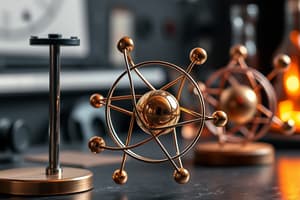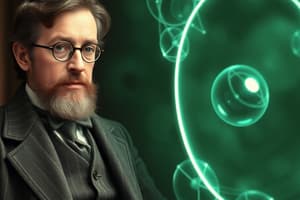Podcast
Questions and Answers
Which model of the atom did John Dalton propose?
Which model of the atom did John Dalton propose?
- Plum pudding model
- Bohr model
- Billiard ball model (correct)
- Nuclear model
What was the limitation of Rutherford's nuclear model?
What was the limitation of Rutherford's nuclear model?
- It could not explain the stability of the atom (correct)
- It was too complicated
- It was not supported by experiments
- It did not include electrons
Niels Bohr's model successfully explained the complex line spectra of multi-electron atoms.
Niels Bohr's model successfully explained the complex line spectra of multi-electron atoms.
False (B)
What does the variable λ represent in the formula λ = h/mv?
What does the variable λ represent in the formula λ = h/mv?
Who developed the wave equation for electrons?
Who developed the wave equation for electrons?
The uncertainty principle was associated with ______.
The uncertainty principle was associated with ______.
How many quantum numbers are needed to describe an electron?
How many quantum numbers are needed to describe an electron?
What does the principal quantum number represent?
What does the principal quantum number represent?
What is indicated by the spin quantum number?
What is indicated by the spin quantum number?
What is the model proposed by John Dalton?
What is the model proposed by John Dalton?
What experiment did Thompson conduct to propose the plum pudding model?
What experiment did Thompson conduct to propose the plum pudding model?
What significant experiment did Rutherford conduct?
What significant experiment did Rutherford conduct?
What model did Niels Bohr propose?
What model did Niels Bohr propose?
Louis de Broglie theorized that particles could have wave properties.
Louis de Broglie theorized that particles could have wave properties.
The equation for matter waves is λ = _____, where λ is wavelength, h is Planck's constant, m is mass, and v is speed of the particle.
The equation for matter waves is λ = _____, where λ is wavelength, h is Planck's constant, m is mass, and v is speed of the particle.
What did Schrödinger develop to describe electrons in atoms?
What did Schrödinger develop to describe electrons in atoms?
What principle did Werner Heisenberg determine?
What principle did Werner Heisenberg determine?
Which of the following describes quantum numbers?
Which of the following describes quantum numbers?
What is the principal quantum number?
What is the principal quantum number?
Flashcards are hidden until you start studying
Study Notes
MODELS OF THE ATOM
- John Dalton: Proposed the billiard ball model, suggesting atoms are solid and indivisible spheres. Limitations include inability to explain isotopes or chemical reactivity.
- J.J. Thomson: Conducted cathode ray experiments leading to the plum pudding model, where electrons are embedded in a positive sphere. Limitations revolve around the lack of a nucleus and the structure’s failure to account for atomic behavior.
- Ernest Rutherford: Gold foil experiment revealed the nuclear model, proposing a dense nucleus surrounded by electrons. Limitations include not accounting for electron stability and behaviors.
- Niels Bohr: Developed the Bohr model based on electromagnetic spectra, introducing quantized orbits for electrons. Limitations found in explaining spectral lines of multi-electron atoms.
- Louis de Broglie: Theorized matter waves, suggesting particles exhibit wave properties similar to light. His equation (λ = h/mv) connects wavelength, mass, and speed. This theory aligns with Bohr's findings but doesn't explain complex electron behaviors.
- Erwin Schrödinger: Integrated wave-like behavior of electrons into atomic models, creating wave functions (Ψ) that illustrate probable electron locations in 3D atomic orbitals.
- Werner Heisenberg: Introduced the uncertainty principle, pinpointing that one cannot simultaneously know an electron's exact position and momentum. His equation (ΔxΔmv ≥ h/4π) outlines this limitation in measurement.
QUANTUM MECHANICAL MODEL
- Evolved from merging de Broglie’s and Einstein’s theories, establishing a model where electrons are viewed as standing waves.
- Describes atomic particles using mathematical equations to express wave properties.
- Electrons have discrete energy levels akin to Bohr's model, with their probable locations represented as atomic orbitals.
QUANTUM NUMBERS
- Quantum numbers stem from solutions to the Schrödinger wave equation, identifying properties of electrons within atoms.
- Four quantum numbers summarize electron specifics:
- Principal Quantum Number (n): Indicates the energy level or shell of the electron.
- Orbital-Shape Quantum Number: Represents the shape of the orbital (sublevel).
- Magnetic Quantum Number: Identifies a specific subshell or orientation of the orbital.
- Spin Quantum Number: Indicates the electron's spin direction.
- Quantum numbers can be visualized as an address for electrons: Country > City > Street > Building.
MODELS OF THE ATOM
- John Dalton: Proposed the billiard ball model, suggesting atoms are solid and indivisible spheres. Limitations include inability to explain isotopes or chemical reactivity.
- J.J. Thomson: Conducted cathode ray experiments leading to the plum pudding model, where electrons are embedded in a positive sphere. Limitations revolve around the lack of a nucleus and the structure’s failure to account for atomic behavior.
- Ernest Rutherford: Gold foil experiment revealed the nuclear model, proposing a dense nucleus surrounded by electrons. Limitations include not accounting for electron stability and behaviors.
- Niels Bohr: Developed the Bohr model based on electromagnetic spectra, introducing quantized orbits for electrons. Limitations found in explaining spectral lines of multi-electron atoms.
- Louis de Broglie: Theorized matter waves, suggesting particles exhibit wave properties similar to light. His equation (λ = h/mv) connects wavelength, mass, and speed. This theory aligns with Bohr's findings but doesn't explain complex electron behaviors.
- Erwin Schrödinger: Integrated wave-like behavior of electrons into atomic models, creating wave functions (Ψ) that illustrate probable electron locations in 3D atomic orbitals.
- Werner Heisenberg: Introduced the uncertainty principle, pinpointing that one cannot simultaneously know an electron's exact position and momentum. His equation (ΔxΔmv ≥ h/4π) outlines this limitation in measurement.
QUANTUM MECHANICAL MODEL
- Evolved from merging de Broglie’s and Einstein’s theories, establishing a model where electrons are viewed as standing waves.
- Describes atomic particles using mathematical equations to express wave properties.
- Electrons have discrete energy levels akin to Bohr's model, with their probable locations represented as atomic orbitals.
QUANTUM NUMBERS
- Quantum numbers stem from solutions to the Schrödinger wave equation, identifying properties of electrons within atoms.
- Four quantum numbers summarize electron specifics:
- Principal Quantum Number (n): Indicates the energy level or shell of the electron.
- Orbital-Shape Quantum Number: Represents the shape of the orbital (sublevel).
- Magnetic Quantum Number: Identifies a specific subshell or orientation of the orbital.
- Spin Quantum Number: Indicates the electron's spin direction.
- Quantum numbers can be visualized as an address for electrons: Country > City > Street > Building.
Studying That Suits You
Use AI to generate personalized quizzes and flashcards to suit your learning preferences.




